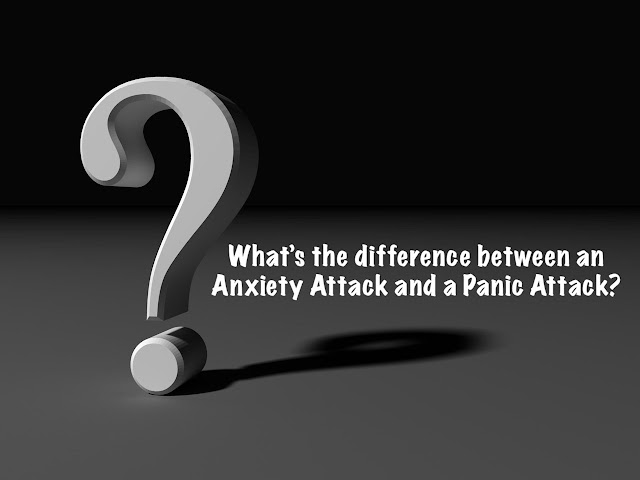What's the difference between an Anxiety Attack and a Panic Attack?
A survey by the Office of National Statistics reported that 39% of adults were experiencing high levels of anxiety since the COVID 19 Lockdown. This is particularly concerning when we consider that this is an increase from 19% from the end of 2019
Naturally, we would expect anxiety alongside the pressures of the environment. For some, it will be an understandable increase in worry and stress, while for others it may have triggered anxiety which can show itself in a number of symptoms, one of which is a panic attack.
Anxiety: a disproportionate fear response. An overestimation of potential threat coupled with an underestimation of a perceived ability to cope.
Worry, Stress or Anxiety?
Many people use the word anxiety interchangeably with panic, as well as worry and stress, which can lead to confusion. It is perfectly reasonable for a person to experience worry and stress, especially with the current circumstances. Worry and stress are a natural emotion that we all experience from time to time. Anxiety is very different. It is an excess of worry and stress. A person’s emotional response is extreme and disproportionate to the circumstances.
Ask yourself… Are my concerns understandable given the circumstances I am experiencing?
Worry, stress and life concerns are still important and need to be managed to ensure that we can move on with life. Those worries can be eased with practical solutions and emotion-focused coping alongside social support. Given these interventions, it is most likely that a person will find their stress (and the symptoms) reduce quickly.Anxiety is an excessive version of this. The usual stress management strategies will have a little long-term effect on the symptoms. Anxiety is an irrational response to the circumstances; an extreme emotional response that is disproportionate to what is being experienced.
Anxiety Verses Panic Attacks
It is helpful to think of anxiety as a persistent state, in contrast to the sudden overwhelming episodes we associate with a panic attack. An ‘attack’ of panic can last from a few minutes to around half-an-hour, but most commonly it will peak and reduce in intensity over that relatively short period of time.Anxiety develops over time. It builds in intensity. Many of the symptoms of the panic attack are present but remain at a lower-level, only on occasion peaking in the panic/anxiety attack.
Thinking about in this way, we could say that panic attacks are symptomatic of anxiety, rather than being separate.
The pressures of the environment increase the development of anxiety. The greater the external pressures from life events, the more likely symptoms such as panic attacks will be triggered. The panic attack is a release value for the anxiety.
Anxiety: a Subtle beast
On-going anxiety does not have to show itself in the dramatic symptoms of the panic attack; they can be much more subtle. The person who recognises that they are becoming irrationally irritated where once they would have been calm may be showing signs of anxiety. Perhaps they find themselves feeling restless or suffering with palpitations and/or excessive sweating. It is typical that someone with on-going anxiety will have noticed a change in their sleep pattern. This may be insomnia but equally possible is the need to sleep more; a feeling of exhaustion regardless of the amount of sleep achieved; what is termed hypersomnia.Remember… the greater the external stress,
the greater the internal stress (anxiety) will be.
In my blogpost “What is the most important question to ask about anxiety?” I outline the origins of the problem. Many people assume that their anxiety is directly related to what is going on in their life right now, but in reality it has been triggered by those current circumstances and, in fact, the result of past experiences.
The emotions from past experiences have accumulated over-time until the pressures of the current circumstances triggered the release of that emotion in the form of the symptoms.
There is a problem though… we are not daft enough to think that the emotional release through the symptoms is reducing the anxiety, in fact, the anxiety symptoms only confirm to the individual that something is wrong… but what?…and that those symptoms will return with increasing regularity.
What can be done? If only you could processes, understand and clear away the emotion that has accumulated over-time. If we could do that, then there would not be the inner anxiety and the symptoms would be relieved too.
Good news… there is a process that can do that: Hypnoanalysis.
Analytical Hypnotherapy
Hypnoanalysis is a type of talking therapy that follows the view of cause and effect. Rather than seeking to simply control the symptoms, the therapy aims to uncover and resolve the cause of the problem. Hypnoanalysis is a way to resolve the bottled up pressures that can lead to anxiety, helping to bring back a person’s resilience.Far from using post-hypnotic suggestion to control the symptoms, Hypnoanalysis removes the cause of the anxiety and as a result the symptoms are relived for good.
Wouldn’t it be nice to be able to make that phone call, attend that social event, be free from that phobia or give that presentation without the uncomfortable feelings of anxiety getting in the way?
Find out more at about anxiety and Hypnoanalysis or contact me to book a free, no-obligation consultation at www.ketteringhypnotherapy.com





Comments
Post a Comment